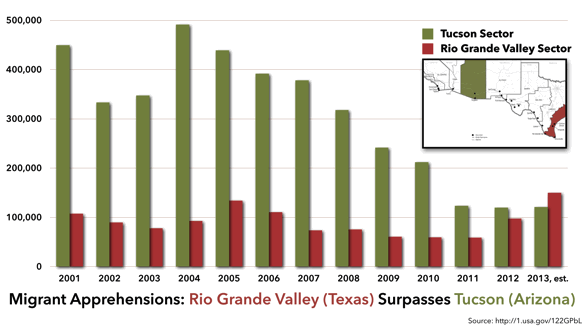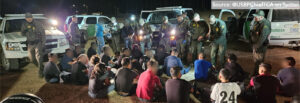Humanitarian concerns as more migrants, mostly Central American, enter south Texas instead of Arizona
Every year since 1998, Arizona has seen more undocumented migration than anywhere else along the U.S.-Mexico border. Out of the nine sectors into which it divides the border, Tucson—which comprises most of Arizona—is where Border Patrol has arrested the most border-crossers.
That seems to have changed in 2013. The new epicenter of undocumented migration is in south Texas.
Last month, as WOLA staff did research for our just-released report on the Tucson sector, Border Patrol officials told us that their apprehensions of undocumented border-crossers increased 1 percent in fiscal year 2013. (Border Patrol measures by government fiscal years, which run from October 1 to September 30.) As they reported apprehending 120,000 in 2012, that would mean a 2013 figure in the low 120,000s.
In late September, the Associated Press reported that another sector of the border was going to beat that number by a large margin. That is the Rio Grande Valley, where the Texas-Mexico border meets the Gulf of Mexico. It comprises McAllen, Brownsville, Harlingen and other small border cities, with a sparsely populated backcountry further north. According to the AP:
Agents from the Border Patrol in Texas’ Rio Grande Valley have apprehended nearly 150,000 [undocumented migrants] so far this fiscal year, a 58 percent increase over 2012. About 94,000 of those border crossers arrested have been from countries other than Mexico.
This is a major shift. There are three things we can learn from it.
1. Migration exhibits a sort of “balloon effect.” The term comes from drug policy critiques: when law enforcement clamps down in one area, the problem pops up elsewhere, as air does when you squeeze a half-filled balloon. The first clampdown took place 20 years ago in El Paso (west Texas) and San Diego (California), which at the time saw the most border-crossers. Greater Border Patrol activity in those areas caused migration to swell in Arizona by the late 1990s. Today, the Tucson sector has the largest Border Patrol presence of any sector. The buildup there, it appears, is now contributing to a sharp increase in south Texas.
2. The growth in migration is almost entirely Central American, not Mexican. The AP estimate of 94,000 apprehended Central American migrants in the Rio Grande Valley sector is stunning. It would be 44,000 more than the number of non-Mexican citizens apprehended [PDF] in that sector in 2012, a 90 percent one-year increase. Between 2011 and 2012, an increase in border-wide migration apprehensions owed completely to a greater number of Central Americans: migration from Mexico continued to decline. In 2013, these new numbers seem to indicate, migration of Mexican citizens has probably continued to reduce or remain stagnant. The numbers also indicate how grim conditions have become in Central America’s “Northern Triangle” countries of Honduras, Guatemala, and El Salvador, which are geographically far closer to south Texas than to other border sectors.
3. Large numbers of people are dying in dangerous terrain. Search and rescue efforts make a difference and should expand. Border Patrol found the remains [PDF] of 463 migrants on U.S. soil in 2012. Only once since 1998 (in 2005) did the agency find more. Between 2002 and 2012, the largest number of migrants, often by far, have died in the Tucson sector’s treacherous deserts. In 2012, Border Patrol reported 177 remains there. In second place, with 150, was the Rio Grande Valley sector of south Texas—up from 66 remains found in 2011. Along with the sharp rise in Central American migration to south Texas last year came an even sharper rise in the number of migrants dying of dehydration and exposure in the area’s “mesquite, soft, sinking sand pits, and baking 100-degree-plus afternoons,” as the local newspaper, The Monitor, describes it.
Though it saw more border-crossers in 2013 than in 2012, the Rio Grande Valley sector may turn out to have been less fatal. In Brooks County just north of the Texas border, the deadliest area because migrants pass through wilderness to avoid a Border Patrol roadblock, the number of remains—while still horribly high—may be down from 2012. The AP reported in late November:
In Brooks County, home to an inland Border Patrol highway checkpoint, authorities found 129 bodies last year. With just over a month left on the calendar, Sheriff’s Chief Deputy Benny Martinez said thankfully it does not appear they’ll match last year’s record death toll. They picked up victim No. 83 on Tuesday, he said.
If the number of remains in Brooks County did decline in 2013, much owes to a determined Border Patrol search and rescue effort in the Rio Grande Valley sector. Here, authorities began adding emergency medical technicians to the routine overflights carried out by Customs and Border Protection’s Office of Air and Marine. This has expanded search and rescue workers’ reach and allowed them to save many more people. This is a worthy effort that should expand to other sectors with high migrant death rates, especially Tucson.


